Page 118 of 509
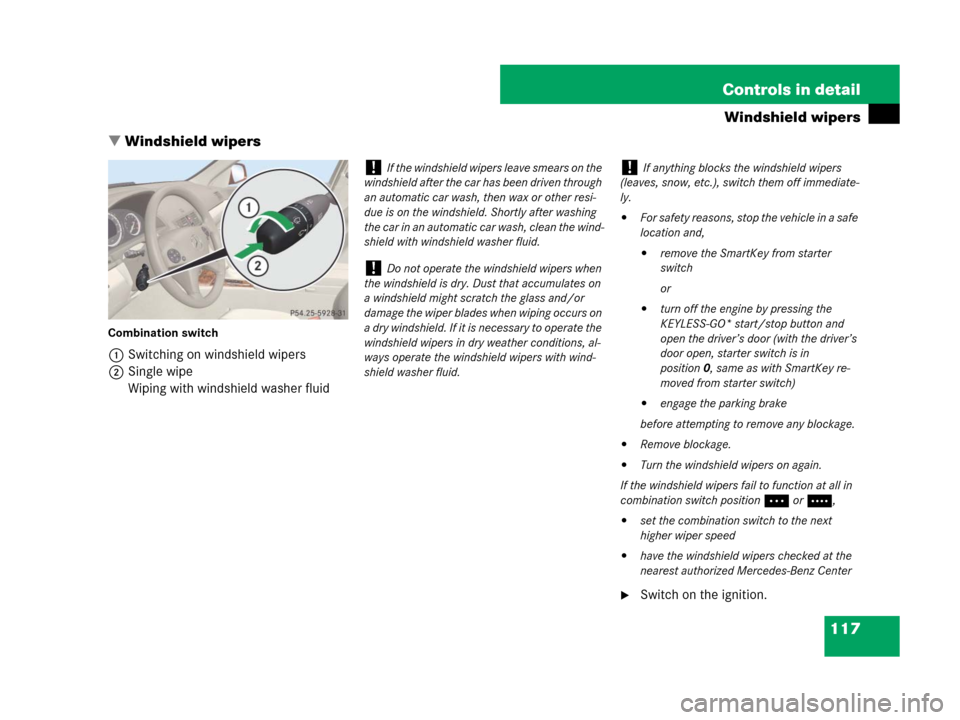
117 Controls in detail
Windshield wipers
�Windshield wipers
Combination switch
1Switching on windshield wipers
2Single wipe
Wiping with windshield washer fluid
�Switch on the ignition.
!If the windshield wipers leave smears on the
windshield after the car has been driven through
an automatic car wash, then wax or other resi-
due is on the windshield. Shortly after washing
the car in an automatic car wash, clean the wind-
shield with windshield washer fluid.
!Do not operate the windshield wipers when
the windshield is dry. Dust that accumulates on
a windshield might scratch the glass and/or
damage the wiper blades when wiping occurs on
a dry windshield. If it is necessary to operate the
windshield wipers in dry weather conditions, al-
ways operate the windshield wipers with wind-
shield washer fluid.
!If anything blocks the windshield wipers
(leaves, snow, etc.), switch them off immediate-
ly.
�For safety reasons, stop the vehicle in a safe
location and,
�remove the SmartKey from starter
switch
or
�turn off the engine by pressing the
KEYLESS-GO* start/stop button and
open the driver’s door (with the driver’s
door open, starter switch is in
position0, same as with SmartKey re-
moved from starter switch)
�engage the parking brake
before attempting to remove any blockage.
�Remove blockage.
�Turn the windshield wipers on again.
If the windshield wipers fail to function at all in
combination switch position U or V,
�set the combination switch to the next
higher wiper speed
�have the windshield wipers checked at the
nearest authorized Mercedes-Benz Center
Page 133 of 509
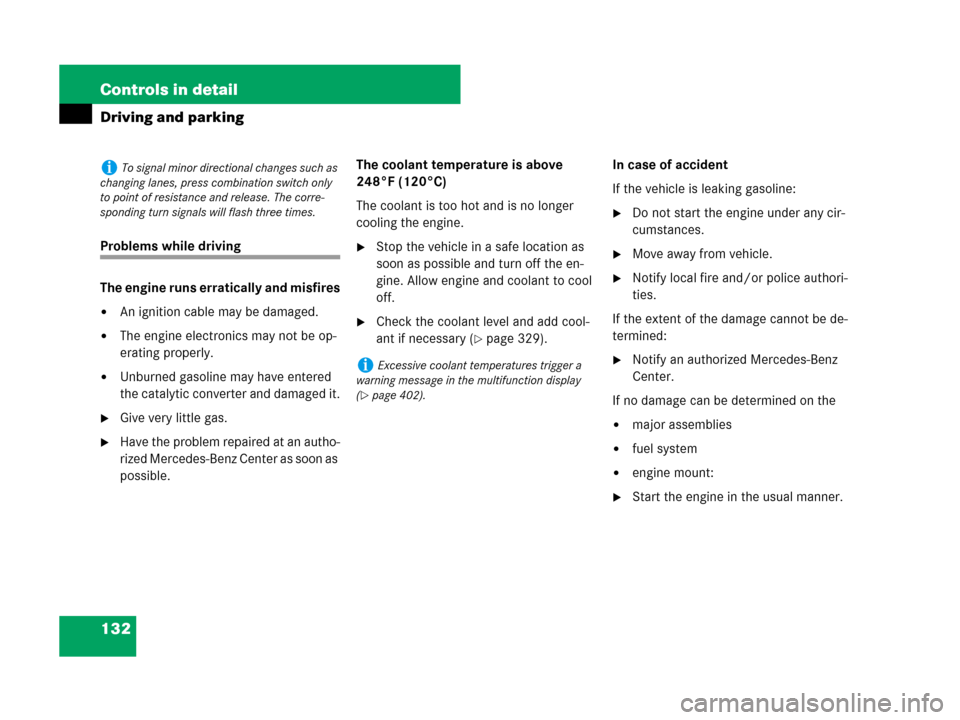
132 Controls in detail
Driving and parking
Problems while driving
The engine runs erratically and misfires
�An ignition cable may be damaged.
�The engine electronics may not be op-
erating properly.
�Unburned gasoline may have entered
the catalytic converter and damaged it.
�Give very little gas.
�Have the problem repaired at an autho-
rized Mercedes-Benz Center as soon as
possible.The coolant temperature is above
248°F (120°C)
The coolant is too hot and is no longer
cooling the engine.
�Stop the vehicle in a safe location as
soon as possible and turn off the en-
gine. Allow engine and coolant to cool
off.
�Check the coolant level and add cool-
ant if necessary (
�page 329).In case of accident
If the vehicle is leaking gasoline:
�Do not start the engine under any cir-
cumstances.
�Move away from vehicle.
�Notify local fire and/or police authori-
ties.
If the extent of the damage cannot be de-
termined:
�Notify an authorized Mercedes-Benz
Center.
If no damage can be determined on the
�major assemblies
�fuel system
�engine mount:
�Start the engine in the usual manner.
iTo signal minor directional changes such as
changing lanes, press combination switch only
to point of resistance and release. The corre-
sponding turn signals will flash three times.
iExcessive coolant temperatures trigger a
warning message in the multifunction display
(
�page 402).
Page 147 of 509
146 Controls in detail
Automatic transmission*
Emergency operation
(Limp-Home Mode)
If vehicle acceleration becomes less re-
sponsive or sluggish or the transmission
no longer shifts, the transmission is most
likely operating in limp-home (emergency
operation) mode. In this mode only second
gear and reverse gear can be selected.
�Stop the vehicle in a safe location.
�Move the gear selector lever to park
positionP.
�Turn off the engine.
�Wait at least 10 seconds before
restarting.
�Restart the engine.
�Move the gear selector lever to
positionD (for second gear) or
positionR.
�Have the transmission checked at an
authorized Mercedes-Benz Center as
soon as possible.
Page 259 of 509

258 Controls in detail
Dual-zone automatic climate control
Air conditioning
The cooling function, only operational
when the engine is running, cools the vehi-
cle interior down to the selected tempera-
ture. The cooling function also
dehumidifies the air in the vehicle interior,
thus preventing the windows from fogging
up.It is possible to deactivate the air condi-
tioning (cooling) function of the climate
control system. The air in the vehicle will
then no longer be cooled or dehumidified.
�Deactivating: Press button2
(
�page 250).
The indicator lamp in the button goes
out.
The cooling function switches off after
a short delay.
Moist air can fog up the windows. You can
dehumidify the air with the air condition-
ing.
�Activating: Press button2
(
�page 250) again.
The indicator lamp in the button comes
on.
The air conditioning uses the
refrigerant R134a. This refrigerant is free
of CFCs which are harmful to the ozone
layer.
Warning!G
If you turn off the cooling function, the
vehicle will not be cooled when weather
conditions are warm and the interior air is
not dried. The windows can fog up more
quickly. Window fogging may impair visibili-
ty and endanger you and others.
iCondensation may drip out from underneath
the vehicle. This is normal and not an indication
of a malfunction.
!If the air conditioning cannot be turned on
again, this indicates that the air conditioning is
losing refrigerant. The compressor has turned it-
self off.
Have the air conditioning checked at the nearest
authorized Mercedes-Benz Center.
Page 268 of 509
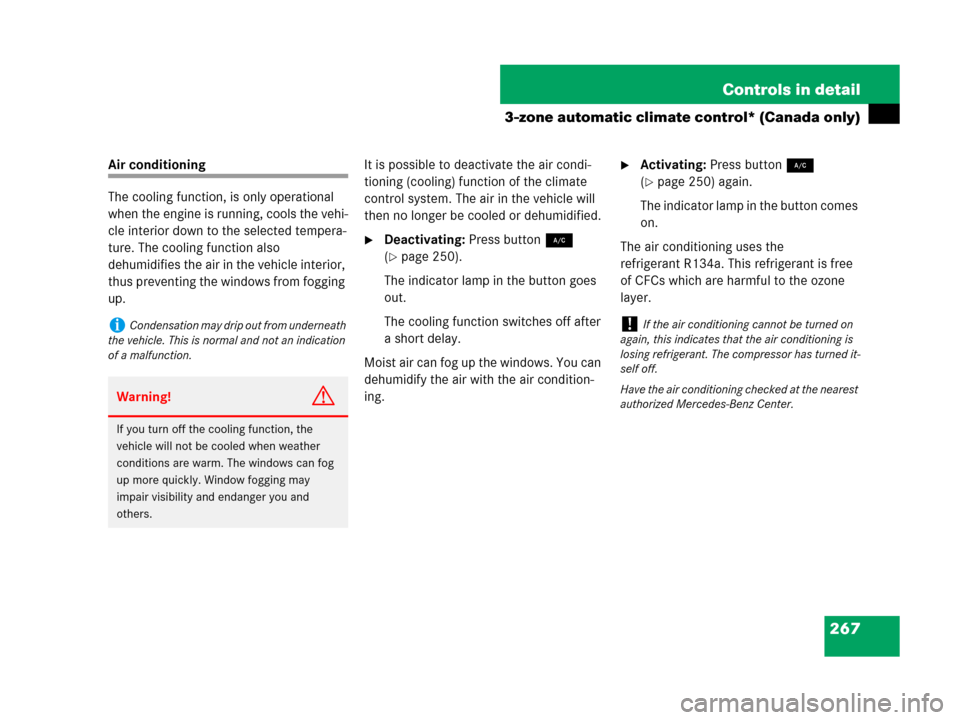
267 Controls in detail
3-zone automatic climate control* (Canada only)
Air conditioning
The cooling function, is only operational
when the engine is running, cools the vehi-
cle interior down to the selected tempera-
ture. The cooling function also
dehumidifies the air in the vehicle interior,
thus preventing the windows from fogging
up.It is possible to deactivate the air condi-
tioning (cooling) function of the climate
control system. The air in the vehicle will
then no longer be cooled or dehumidified.
�Deactivating: Press button2
(
�page 250).
The indicator lamp in the button goes
out.
The cooling function switches off after
a short delay.
Moist air can fog up the windows. You can
dehumidify the air with the air condition-
ing.
�Activating: Press button2
(
�page 250) again.
The indicator lamp in the button comes
on.
The air conditioning uses the
refrigerant R134a. This refrigerant is free
of CFCs which are harmful to the ozone
layer.
iCondensation may drip out from underneath
the vehicle. This is normal and not an indication
of a malfunction.
Warning!G
If you turn off the cooling function, the
vehicle will not be cooled when weather
conditions are warm. The windows can fog
up more quickly. Window fogging may
impair visibility and endanger you and
others.
!If the air conditioning cannot be turned on
again, this indicates that the air conditioning is
losing refrigerant. The compressor has turned it-
self off.
Have the air conditioning checked at the nearest
authorized Mercedes-Benz Center.
Page 314 of 509
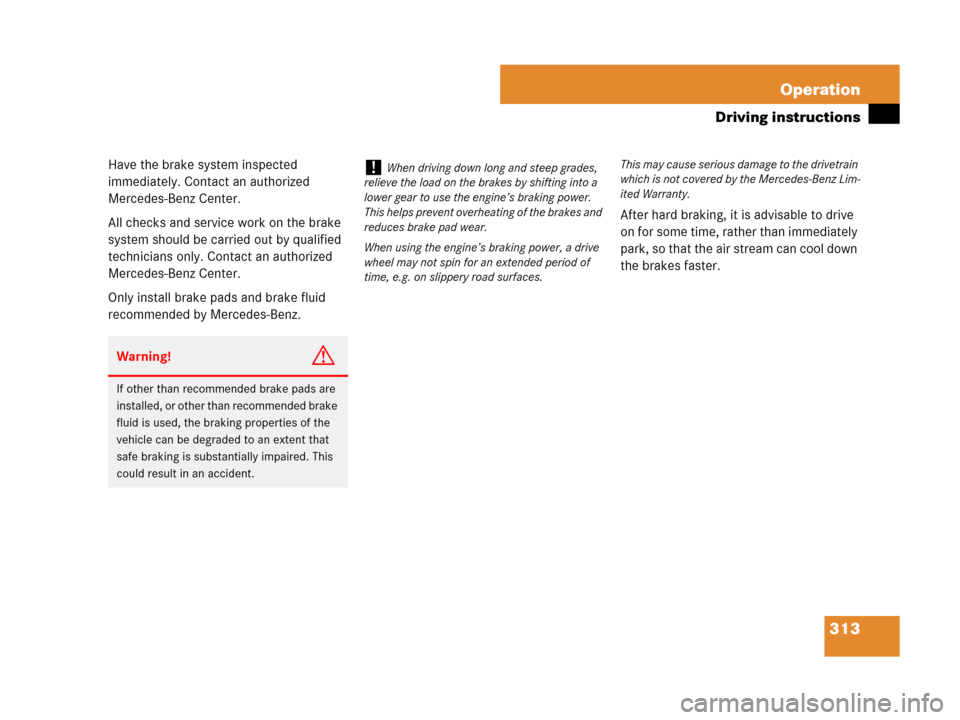
313 Operation
Driving instructions
Have the brake system inspected
immediately. Contact an authorized
Mercedes-Benz Center.
All checks and service work on the brake
system should be carried out by qualified
technicians only. Contact an authorized
Mercedes-Benz Center.
Only install brake pads and brake fluid
recommended by Mercedes-Benz.After hard braking, it is advisable to drive
on for some time, rather than immediately
park, so that the air stream can cool down
the brakes faster.
Warning!G
If other than recommended brake pads are
installed, or other than recommended brake
fluid is used, the braking properties of the
vehicle can be degraded to an extent that
safe braking is substantially impaired. This
could result in an accident.
!When driving down long and steep grades,
relieve the load on the brakes by shifting into a
lower gear to use the engine’s braking power.
This helps prevent overheating of the brakes and
reduces brake pad wear.
When using the engine’s braking power, a drive
wheel may not spin for an extended period of
time, e.g. on slippery road surfaces.This may cause serious damage to the drivetrain
which is not covered by the Mercedes-Benz Lim-
ited Warranty.
Page 325 of 509
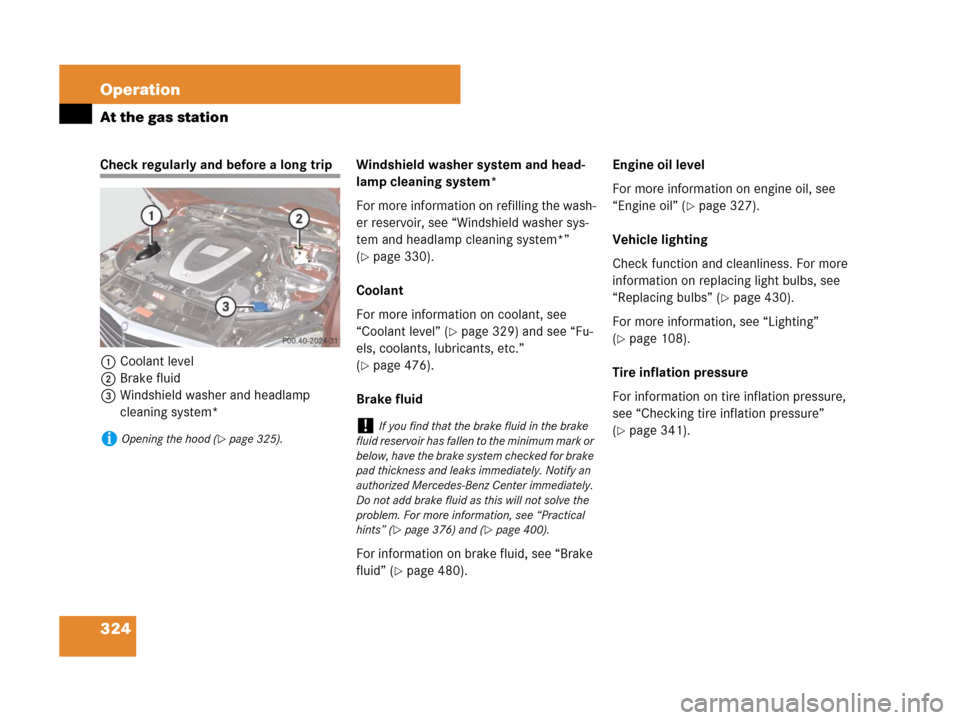
324 Operation
At the gas station
Check regularly and before a long trip
1Coolant level
2Brake fluid
3Windshield washer and headlamp
cleaning system*Windshield washer system and head-
lamp cleaning system*
For more information on refilling the wash-
er reservoir, see “Windshield washer sys-
tem and headlamp cleaning system*”
(
�page 330).
Coolant
For more information on coolant, see
“Coolant level” (
�page 329) and see “Fu-
els, coolants, lubricants, etc.”
(
�page 476).
Brake fluid
For information on brake fluid, see “Brake
fluid” (
�page 480).Engine oil level
For more information on engine oil, see
“Engine oil” (
�page 327).
Vehicle lighting
Check function and cleanliness. For more
information on replacing light bulbs, see
“Replacing bulbs” (
�page 430).
For more information, see “Lighting”
(
�page 108).
Tire inflation pressure
For information on tire inflation pressure,
see “Checking tire inflation pressure”
(
�page 341).iOpening the hood (�page 325).!If you find that the brake fluid in the brake
fluid reservoir has fallen to the minimum mark or
below, have the brake system checked for brake
pad thickness and leaks immediately. Notify an
authorized Mercedes-Benz Center immediately.
Do not add brake fluid as this will not solve the
problem. For more information, see “Practical
hints” (
�page 376) and (�page 400).
Page 327 of 509
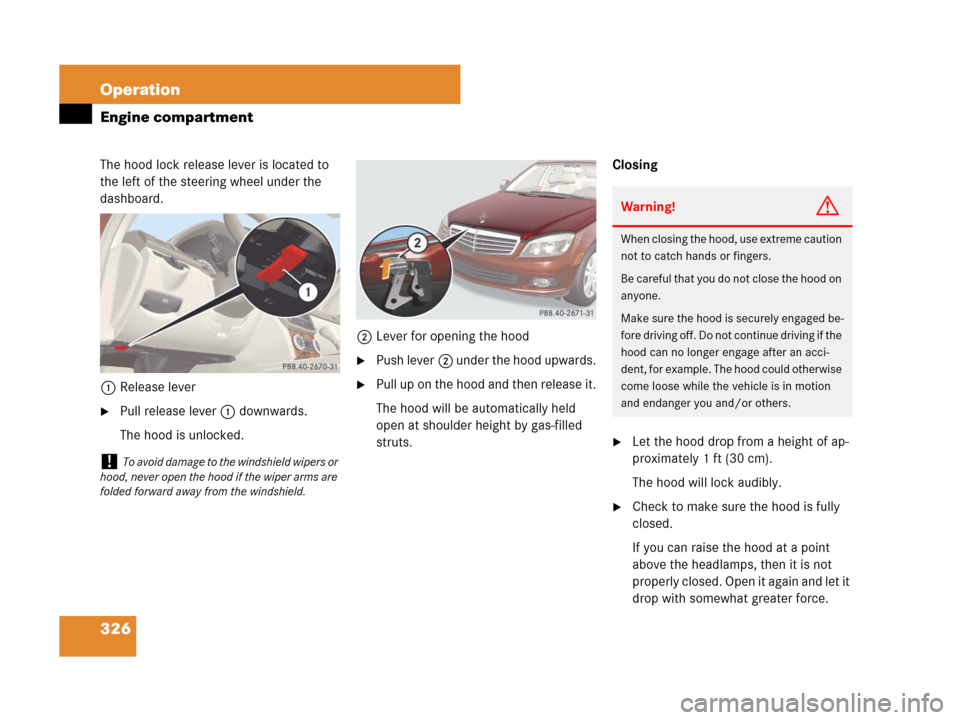
326 Operation
Engine compartment
The hood lock release lever is located to
the left of the steering wheel under the
dashboard.
1Release lever
�Pull release lever 1 downwards.
The hood is unlocked.2Lever for opening the hood
�Push lever2 under the hood upwards.
�Pull up on the hood and then release it.
The hood will be automatically held
open at shoulder height by gas-filled
struts. Closing
�Let the hood drop from a height of ap-
proximately 1 ft (30 cm).
The hood will lock audibly.
�Check to make sure the hood is fully
closed.
If you can raise the hood at a point
above the headlamps, then it is not
properly closed. Open it again and let it
drop with somewhat greater force.
!To avoid damage to the windshield wipers or
hood, never open the hood if the wiper arms are
folded forward away from the windshield.
Warning!G
When closing the hood, use extreme caution
not to catch hands or fingers.
Be careful that you do not close the hood on
anyone.
Make sure the hood is securely engaged be-
fore driving off. Do not continue driving if the
hood can no longer engage after an acci-
dent, for example. The hood could otherwise
come loose while the vehicle is in motion
and endanger you and/or others.